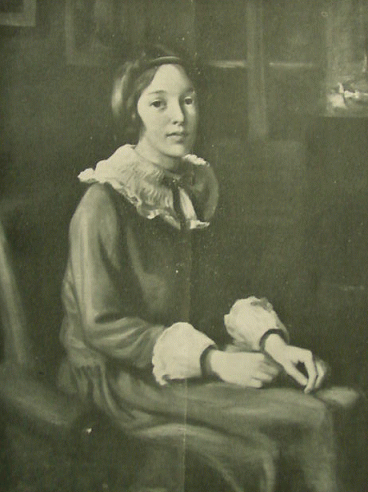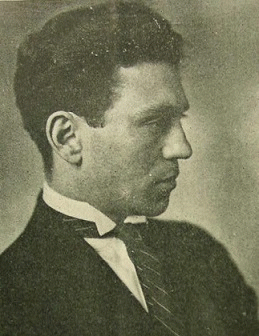Nancy sat poised for her portrait in what appears to be a comfortable leather chair, most likely in the family apartment in Manhattan. The apartment was not a roomy, sleek affair. Rather, it was one suited to the vagaries of the income of an insurance broker, dependent on commissions, hard work and a stable economy. The prosperity of the 1920s took care of the last of these, but Frederic's ability to churn out deals must have lagged as his problem with alcohol became more acute. The dwellings the family chose to live in became successively more humble, until the family settled in a walk-up apartment building of a rather standard sort on the West Side - nothing over-roomy.
So here Nancy sits, almost a caricature of a little girl, a bit hunched over like the lanky 14 year old that she was. Yet in comparison with a later portrait drawn by Rembski at the end of 1924, we see two different people. The later portrait is of a distinguished, sophisticated, and elegant young woman beginning to achieve the knowledge of herself and her ambitions - one who is at last peeping over the heads of her adult handlers and recognizing that she will be a player in life as well. Even though Rembski has dated the earlier portrait 1924 on the back of a photograph of the same, one can't help but think that it was completed much earlier, and that the date he assigned to it was that of its first public showing rather than of its execution. The little girl in the portrait seems to be far too young to have emerged as the mature woman of only a year later.
The unusual frills on the the borders of Nancy's cuffs and collar are nothing but charming, even if they do harken back to an earlier era. The girl underneath the frills still retains that sheepish quality of youth that so properly matches her outfit. Nancy and her environs were an ideal subject for Rembski.
Judging from the selection of sitters for his early portraits in America, Rembski was enchanted by young women, and Nancy was no exception. In spite of her youth, she was an attractive subject, one just coming of age into womanhood, perhaps pushed into clothing that demonstrated more her mother's reluctance to see her daughter grow up than Nancy's actual level of maturity. Nancy enjoyed both the extreme charms of playfulness and a desire to mature, although the earlier attribute is most evident in her portrait. She looks out with a quite charm, as if to say, "I am in this young body now. But patience! In a year, time and nature will have done their work." She is not discontent with her station in life. She is in oneness with her environment and with her fate, which, aside from the loss of her father, was a happy one.
In the background of the portrait, on the wall to Nancy's right, two paintings hang on the wall. What they might be, we cannot say. Let us assume that they represent her ancestors, dating as far back as the regency of England. Nancy was aware that she descended from a glorious past, whatever the present may have dealt her. Yet, these ancestors were not more than a fantasy to the young girl. They may have helped her keep a level of self respect among peers in school who could sometimes be unkind, or outright mean in extreme cases, particularly if their families were doing better economically than hers was.
Nancy had large eyes and high cheekbones. This unusual facial topography would become even more pronounced in later years. Her hands taper into beautifully formed fingers, resting casually on her dress. Rembski was able to find the most natural positioning of the hands, a feat that often eluded him in later portraits. It was a problem that would come to dominate many of his works--where to put those inconvenient hands! But Nancy's rest comfortably--a natural extension of herself--and are gently positioned in front of her. Her dress flows down to the midpoint of her calves where it finally leaves the scope of the portrait.
According to accounts, the dress is green velvet, and Rembski has managed to capture both the feel and consistency of the material. While we, who do not have the original in front of us, must use our intuition to grasp what is no longer visible, it is not so severe a limitation that we cannot sense the portrait's impact. Bernard Berenson, the art connoisseur who thrived during the first half of the 20th Century, believed that black and white photos of paintings captured the spirit of a work better than ones in full color.
Directly behind and above Nancy is a window. The window is closed, and one can imagine that it represents the future -- Nancy's future, which she is to create herself. That is why it is still dark and unformed. There is nothing to be seen outside the window, because her own life has yet to create that picture. Also in the background is a dresser, and a decorative piece of some kind. The dresser symbolizes Nancy's future domestic life, and the decorative piece, her future mate, the crown of her domestication.
We see, then, not just a portrait, but a living representation of the past and future in Rembski's portrait. How was it to be that the artist could be so insightful as to render such a sensitive portrayal of the young girl, one that would keep its charm through the decades up to the present era?
When I showed a picture of this portrait to the proprietor of a gallery who had known Nancy in her later years, the woman surprised me by saying, "Nancy always looked like that." When I asked how this could be, noting the great discrepancy between the age of the young girl and what she must have looked like in her later years when the gallery owner knew her, the woman insisted again, "Nancy always looked like that." I was dumbfounded. There are so many testimonies of Rembski's portraits evoking that type of reaction, but to see it happen before my eyes--me, a skeptic as much as a believer--was a surprise.
The shadowy background, which Rembski uses to highlight Nancy's features, often appears in other Rembski portraits of the period. Note the surprising way Nancy's countenance dominates the entire painting--not by force, but by her sublime calm, by projecting the peacefulness of her youth. Rembski has captured that moment.
As the artist applied his paint to canvas, what might he have been thinking? Surely, he noted Nancy's natural beauty. Then, there was her endearing character. She loved to fantasize, and she was really not a quiet child in the presence of the right company. When she felt a certain way, she would be outspoken about it. We can imagine a dialogue between Nancy and Rembski, one that was not to end with the completion of this first portrait. Rembski, who, as has already been emphasized, was not immune to Nancy's charms, might have warmed up to her. And Nancy must have been quite taken by this lively character, filled with artistic ambition and mellowed by the experience of 10 years of serious artistic endeavor. Whatever may have been undesirable to the opposite sex about his relatively short stature--5' 6"-- and dark complexion, was more than compensated for by his sharp eastern European features. His broken English had its own charm, and Nancy, faced with this masculine tour de force, must have not taken long to succumb. The sight of an artist really at work, the easel, the canvas, the shaping of the portrait, the mastery of the skill, the smell of the paint, - must have left a lasting impression on Nancy, not one of just the painter's masculine charm, but of the aesthetic heights that could be scaled in appreciation of all the trappings of artistic activity. Painter and poser bonded in their own way, for Nancy would rarely miss an opportunity to see Rembski in the next several years.
Two other women were no doubt equally impressed with Rembski's charm. One was Esther, who must have arranged with Rembski to have her daughter's portrait painted. Esther was not the type to leave anything to fate. Nancy had just lost the most important person in her life next to her mother. Her own grieving aside, Esther was sensitive to what Nancy was going through. The portrait sitting was another way to raise Nancy's spirits and find positive distractions to ease a traumatic loss. A young girl's thoughts of her own mortality after the death of a loved one must have also intruded into her consciousness. It was these various broodings that Esther wanted to steer her daughter away from, or at least resolve them in a positive direction. In light of Esther's predicament, Rembski was a godsend. Nancy would not only be taught an important cultural lesson, but it would be accomplished through a lively and colorful figure - a real artist!
Esther was by no means immune to Rembski's charms. While her 45 years would put her far beyond what was practical in a conventional romantic attachment, compared, that is, to Rembski's 27 years, Esther could still have felt an attraction to the young gentleman, and a gentleman he was. He retained all the European charms he had learned while painting the royalty of Silesia. And his Jewish background would have prepared him for the proper manners with which others should be treated. Esther, then, was as much charmed by the Pole as her daughter was, although their affections were transformed into a form appropriate to their respective ages--for the younger, an infatuation, and for the older, that of an enduring friendship.
(Note: You can view every article as one long page if you sign up as an Advocate Member, or higher).






